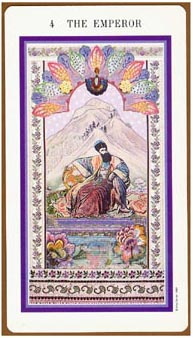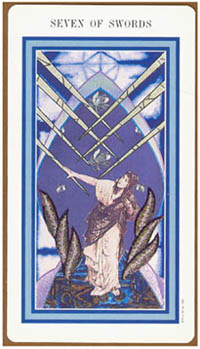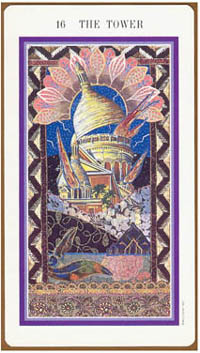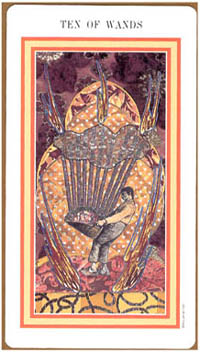|
 I got my first impression of "The Enchanted Tarot" from the 1991 calendar made for it. Large impressive
pictures, even if they were too detailed in my opinion for a calendar. Now I have the deck proper in my
hands and, additionally, the entire deck is reproduced in color in the accompanying book.
I got my first impression of "The Enchanted Tarot" from the 1991 calendar made for it. Large impressive
pictures, even if they were too detailed in my opinion for a calendar. Now I have the deck proper in my
hands and, additionally, the entire deck is reproduced in color in the accompanying book.
 We have here a fine example on how printing technique, paper and size affect the final result.
Unfortunately, in this case, the tarot deck proper is the least acceptable of the three versions, the
best being the rendition in the book. The illustrations in the book reveal, that Amy Zerner's artwork is
really enchanting. The many fine details in each card come to their right, the fine needlework, like old
trimmings, laces and crochet work, which are part of the designs, can be seen distinctly. In the final
product, the card deck, these details are almost lost, and only appear as a colored, indeterminable
pattern. I like "The Enchanted Tarot", as it appears in the book. It is a refreshing new way to create a
tarot deck. The collage technique used is a mixture of remnants of needlework, paintings on fabric and
silk-screened or printed images, all woven together to make up a fascinating fairy world.
We have here a fine example on how printing technique, paper and size affect the final result.
Unfortunately, in this case, the tarot deck proper is the least acceptable of the three versions, the
best being the rendition in the book. The illustrations in the book reveal, that Amy Zerner's artwork is
really enchanting. The many fine details in each card come to their right, the fine needlework, like old
trimmings, laces and crochet work, which are part of the designs, can be seen distinctly. In the final
product, the card deck, these details are almost lost, and only appear as a colored, indeterminable
pattern. I like "The Enchanted Tarot", as it appears in the book. It is a refreshing new way to create a
tarot deck. The collage technique used is a mixture of remnants of needlework, paintings on fabric and
silk-screened or printed images, all woven together to make up a fascinating fairy world.
 The Enchanted Tarot is a full deck of 78 cards, all illustrated in the book. The minor arcana is also
illustrated, and even if there is a vague resemblance of the Waite-Smith imagery, the deck looks very
different. The figures, partly magazine illustrations, are mainly taken from Victorian or early 20th
century sources. The cards are not particularly small, that is not the reason, nor is the cardboard of
a bad quality, but the highlights in the collages are lost, resulting in a dull look, compared to the
illustrations in the book. The card design is framed in itself, but an additional white border takes up
too much of the card surface. When will manufacturers learn, that in general we do not need those broad
white surrounding frames?
The Enchanted Tarot is a full deck of 78 cards, all illustrated in the book. The minor arcana is also
illustrated, and even if there is a vague resemblance of the Waite-Smith imagery, the deck looks very
different. The figures, partly magazine illustrations, are mainly taken from Victorian or early 20th
century sources. The cards are not particularly small, that is not the reason, nor is the cardboard of
a bad quality, but the highlights in the collages are lost, resulting in a dull look, compared to the
illustrations in the book. The card design is framed in itself, but an additional white border takes up
too much of the card surface. When will manufacturers learn, that in general we do not need those broad
white surrounding frames?
 The book's text is by Monte Faber, whom we know from "Karma Cards". He is also the husband of Mrs. Zerner.
The text claims, that C.G.Jung was "also a student of the tarot", which is surely news for most of us,
and also that "hand painted cards were used by the wise elders to teach life lessons to the illiterate
populations of India, China and, later, Europe". With these two statements on the first pages, there is
not much reason to believe the rest of the text, is there? Each card is described under three headings:
The Dream, The Awakening, The Enchantment. "The Dream", being a small fable, explaining the card's
imagery. "The Awakening" is the fable brought into everyday life, i.e. how shall we interpret it.
"The Enchantment" is an invitation to the reader to do a ritual, a chant, make a spell, act in some way,
to "provide a link between our waking world and the land of dreams"!
The book's text is by Monte Faber, whom we know from "Karma Cards". He is also the husband of Mrs. Zerner.
The text claims, that C.G.Jung was "also a student of the tarot", which is surely news for most of us,
and also that "hand painted cards were used by the wise elders to teach life lessons to the illiterate
populations of India, China and, later, Europe". With these two statements on the first pages, there is
not much reason to believe the rest of the text, is there? Each card is described under three headings:
The Dream, The Awakening, The Enchantment. "The Dream", being a small fable, explaining the card's
imagery. "The Awakening" is the fable brought into everyday life, i.e. how shall we interpret it.
"The Enchantment" is an invitation to the reader to do a ritual, a chant, make a spell, act in some way,
to "provide a link between our waking world and the land of dreams"!
I can do without Mr. Faber's text, but I cannot do without the book, because of its illustrations.
The whole set is packed in a cassette of thin cardboard with the cards piled up along with the book
in three stacks. Once you have got them out, they are difficult to get properly back in again. OK, they
are meant to be used, but there is no way to keep them together unless you use a rubber band or turn to
the old tradition of wrapping them in a black cloth. The book is hard cover and is an excellent printing.
There is even a build-in silken cord to use as a marker.
|